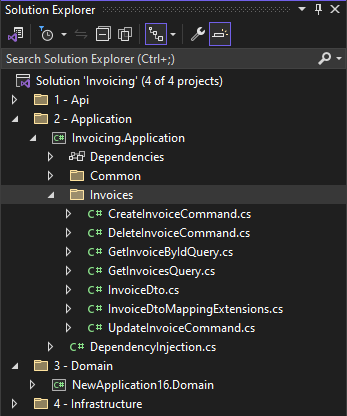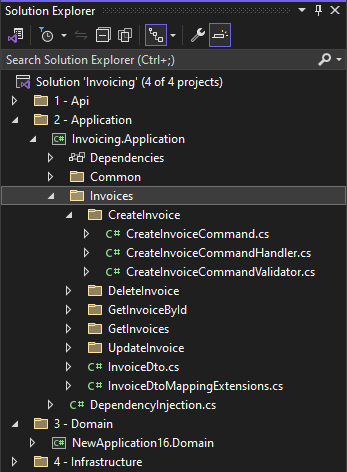Intent.Application.MediatR
This Intent Architect module realizes a CQRS design pattern using MediatR, for Service's modeled in the Services Designer using the CQRS paradigm.
CQRS (Command Query Responsibility Segregation) using MediatR is a software design pattern and library combination that separates read and write operations in an application. MediatR serves as the Mediator, handling commands and queries, and routing them to their respective command and query handlers. Commands represent intentions to change the application's state, while queries retrieve data without making modifications. This approach promotes separation of concerns, scalability, and testability, allowing for clearer codebases and aligning well with Domain-Driven Design principles, ultimately resulting in more maintainable and efficient applications.
This module produces the following artifacts:
- Command Interface -
ICommandinterface for identifying commands. - Query Interface-
IQueryinterface for identifying querys. - Commands - Classes representing all the modelled
Commands. - CommandHandlers - MediatR request handlers for all the modelled
Commands - Querys- Classes representing all the modelled
Querys. - QueryHandlers - MediatR request handlers for all the modelled
Querys
CQRS Settings
CQRS Settings - Consolidate Command/Query associated files into single file
When set to disabled (the default), each command/query is generated into its own sub-folder with its handler and validator (when applicable) alongside it in the same sub-folder.

When set to enabled, commands and queries no longer have their own sub-folders and files which used to be generated alongside them are now instead generated into the handler/command file itself.

Examples
This module consumes:

And produce artifacts similar to:
Command Example
public class CreateCustomerCommand : IRequest<Guid>, ICommand
{
public CreateCustomerCommand(string name, string surname, string email)
{
Name = name;
Surname = surname;
Email = email;
}
public string Name { get; set; }
public string Surname { get; set; }
public string Email { get; set; }
}
CommandHandler Example
public class CreateCustomerCommandHandler : IRequestHandler<CreateCustomerCommand, Guid>
{
public async Task<Guid> Handle(CreateCustomerCommand request, CancellationToken cancellationToken)
{
...
}
}
For more information on MediatR, check out their official GitHub.
Property default values
When designing in the Intent Architect Services designer, Commands can be created with properties, and these properties can have default values. When a default value is supplied, it will be used in the constructor of the Command, provided the property is not proceeded by another property which does not have a default value..
In the below example, in the Service designer, the name property was set with a default value, however it is not being used in the constructor. This is due to the fact there are properties proceeding it which do not have a default value.
public class CreateCustomerCommand : IRequest<Guid>, ICommand
{
public CreateCustomerCommand(string? name, string surname, string email)
{
Name = name;
Surname = surname;
Email = email;
}
public string? Name { get; set; }
public string Surname { get; set; }
public string Email { get; set; }
}
To ensure the default is set, in the Intent Architect Services designer the name property should be moved to after all properties without a default value, which will then result in the following code:
public class CreateCustomerCommand : IRequest<Guid>, ICommand
{
public CreateCustomerCommand(string surname, string email, string? name = "my default value")
{
Surname = surname;
Email = email;
Name = name;
}
public string Surname { get; set; }
public string Email { get; set; }
public string? Name { get; set; }
}
The designer will also raise a warning if the Command has been incorrectly configured (but will still allow the Software Factory to be executed)
Commercial License Options
Starting with MediatR v13.0, a commercial license is required. All versions prior to v13.0 remain free to use.
From version 4.5.0+ of Intent.Application.MediatR, you can control which version is used via the Use Pre-Commercial Version application setting:

- Enabled : Locks MediatR to the last free version (pre-commercial).
- Disabled : Uses the latest commercial edition.
Warning
If you choose to use a commercial version, you must obtain and configure a valid license key.
License keys can be requested following the instructions in Jimmy Bogard's article.
Keys should be configured in your appsettings.json under:
{
"MediatR": {
"LicenseKey": "<your-license-key>"
}
}
Alternatively, you can set it as an environment variable:
MediatR__LicenseKey=<your-license-key>